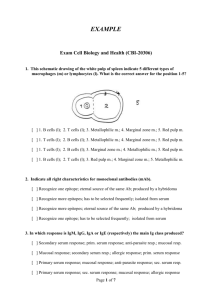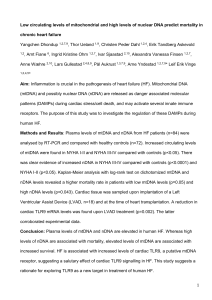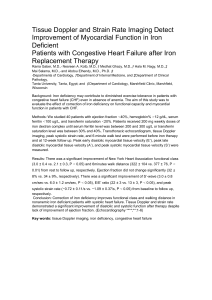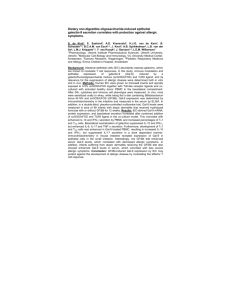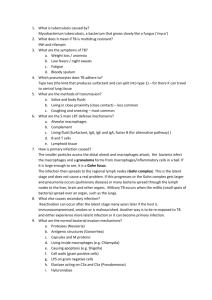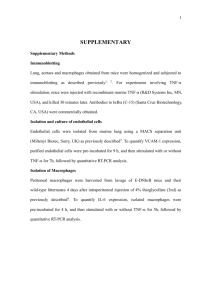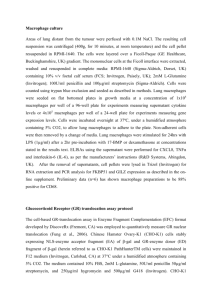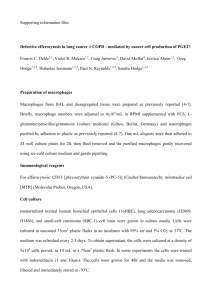Granulin Is a Soluble Cofactor for Toll-like Receptor 9 Signaling Please share
advertisement
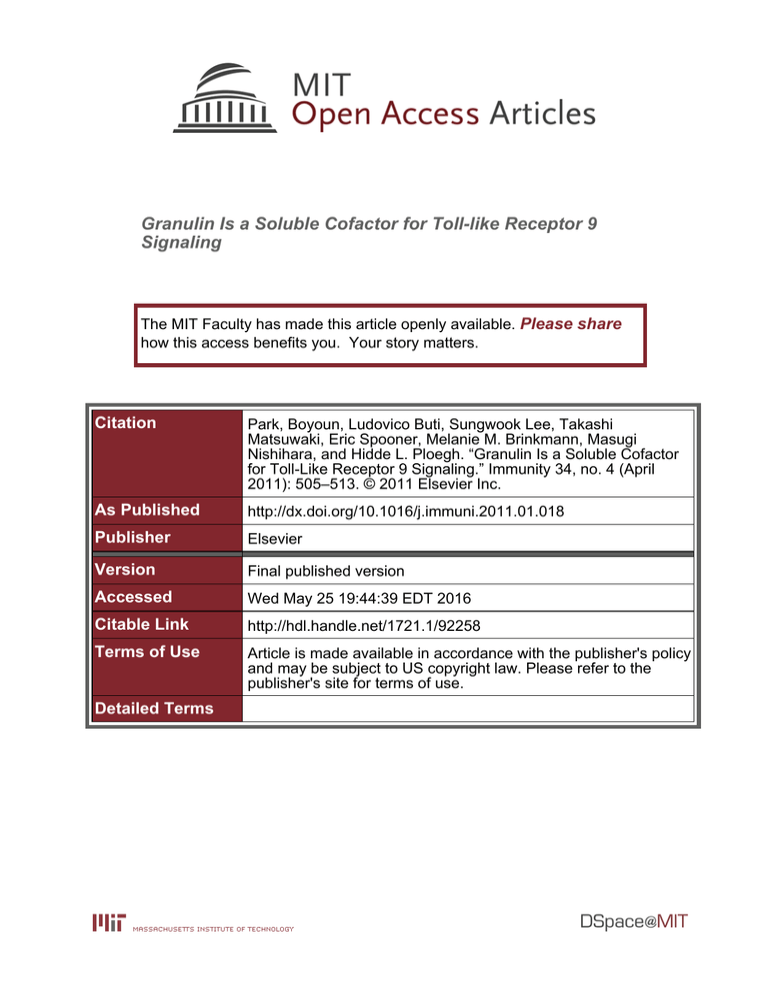
Granulin Is a Soluble Cofactor for Toll-like Receptor 9 Signaling The MIT Faculty has made this article openly available. Please share how this access benefits you. Your story matters. Citation Park, Boyoun, Ludovico Buti, Sungwook Lee, Takashi Matsuwaki, Eric Spooner, Melanie M. Brinkmann, Masugi Nishihara, and Hidde L. Ploegh. “Granulin Is a Soluble Cofactor for Toll-Like Receptor 9 Signaling.” Immunity 34, no. 4 (April 2011): 505–513. © 2011 Elsevier Inc. As Published http://dx.doi.org/10.1016/j.immuni.2011.01.018 Publisher Elsevier Version Final published version Accessed Wed May 25 19:44:39 EDT 2016 Citable Link http://hdl.handle.net/1721.1/92258 Terms of Use Article is made available in accordance with the publisher's policy and may be subject to US copyright law. Please refer to the publisher's site for terms of use. Detailed Terms Immunity Article Granulin Is a Soluble Cofactor for Toll-like Receptor 9 Signaling Boyoun Park,1,* Ludovico Buti,2,3 Sungwook Lee,1 Takashi Matsuwaki,4 Eric Spooner,2 Melanie M. Brinkmann,2,5 Masugi Nishihara,4 and Hidde L. Ploegh2,* 1Department of Systems Biology, College of Life Science and Biotechnology, Yonsei University, Seoul 120-749, South Korea Institute for Biomedical Research, Massachusetts Institute of Technology, 9 Cambridge Center, Cambridge, MA 02115, USA 3Novartis Vaccines and Diagnostics, Research Center, 53100 Siena, Italy 4Department of Veterinary Physiology, Veterinary Medical Science, The University of Tokyo, Tokyo 113-8657, Japan 5Present address: Helmholtz Center for Infection Research, Inhoffenstrasse 7, 38124 Braunschweig, Germany *Correspondence: bypark@yonsei.ac.kr (B.P.), ploegh@wi.mit.edu (H.L.P.) DOI 10.1016/j.immuni.2011.01.018 2Whitehead SUMMARY Toll-like receptor (TLR) signaling plays a critical role in innate and adaptive immune responses and must be tightly controlled. TLR4 uses LPS binding protein, MD-2, and CD14 as accessories to respond to LPS. We therefore investigated the presence of an analagous soluble cofactor that might assist in the recruitment of CpG oligonucleotides (CpG-ODNs) to TLR9. We report the identification of granulin as an essential secreted cofactor that potentiates TLR9-driven responses to CpG-ODNs. Granulin, an unusual cysteine-rich protein, bound to CpG-ODNs and interacted with TLR9. Macrophages from granulin-deficient mice showed not only impaired delivery of CpG-ODNs to endolysosomal compartments, but also decreased interaction of TLR9 with CpGODNs. As a consequence, granulin-deficient macrophages showed reduced responses to stimulation with CpG-ODNs, a trait corrected by provision of exogenous granulin. Thus, we propose that granulin contributes to innate immunity as a critical soluble cofactor for TLR9 signaling. INTRODUCTION Toll-like receptors (TLRs) perceive diverse macromolecules of microbial origin (Janeway and Medzhitov, 2002; Kawai and Akira, 2010; Takeda et al., 2003). TLR1, TLR2, TLR4, TLR5, and TLR6 all recognize different components from bacteria and fungi and are found on the cell surface (Buwitt-Beckmann et al., 2006; Hayashi et al., 2001; Latz et al., 2002; Takeuchi et al., 2002). In contrast, TLR3, TLR7, TLR8, and TLR9 detect nucleic acids and are found in endolysosomal compartments (Matsumoto et al., 2003; Nishiya and DeFranco, 2004; Nishiya et al., 2005). In resting myeloid cells, the predominant localization of TLR9 to the endoplasmic reticulum (ER) changes to an endolysosomal localization upon stimulation with CpG-ODNs (Barton et al., 2006; Kim et al., 2008; Latz et al., 2004). The activation of TLR9 presents a special case: synthesized in the ER as a full-length precursor, the ectodomain of TLR9 undergoes proteolytic cleavage by endolysosomal proteases, a conversion that is essential for its function (Ewald et al., 2008; Park et al., 2008). TLR4 stands out because it engages its ligand LPS through involvement of MD-2, CD14, and the LPS binding protein (LBP) to achieve full activation (Jiang et al., 2005; Lazou Ahrén et al., 2001; Schromm et al., 2001; Shimazu et al., 1999). TLR2 interacts functionally with unrelated proteins such as CD36 (Hoebe et al., 2005; Stewart et al., 2010). In the case of TLR7, the ability of small molecules such as imidazoquinolines to activate this TLR is not easily reconciled with the stimulatory properties of its much larger natural ligands, and thus suggests the involvement of accessory molecules (Hemmi et al., 2002). In addition, the details of how TLR9 perceives stimulatory CpG-ODN and distinguishes them from inhibitory ODN are unclear. Here we identify granulin and fragments derived from it as interactors of TLR9 and investigate their contribution to TLR9 activation as a critical soluble cofactor. Granulin is a multifunctional protein that regulates cell growth, development, and tissue remodeling (Bateman et al., 1990; Plowman et al., 1992; Shoyab et al., 1990). Granulin, a protein with a repeating cysteine-rich motif, has also been linked to inflammation, regulation of innate immunity, and wound healing (Yin et al., 2010; Zhu et al., 2002), but its possible involvement in TLR signaling remains to be explored. Here we report that granulin bound to CpG-ODNs contributed to delivery of CpG-ODNs to endolysosomal compartments and thereby plays a pivotal role in TLR9 function. RESULTS Identification of Granulin(s) as Interacting Partners of TLR9 Putative cofactors that assist TLR9 in the binding of CpG-ODNs in endolysosomal compartments might themselves be subject to proteolysis, like TLR9. We therefore exposed RAW macrophages that stably expressed TLR9 tagged at the C terminus with Myc (TLR9-Myc) to z-FA-fmk, a cysteine protease inhibitor, to block proteolytic conversion of putative cofactors or to DMSO. We then labeled cells for 2 hr with [35S]methionine and cysteine, followed by a chase for 6 hr, after which we immunoprecipitated TLR9-Myc with a Myc-specific antibody (Figure 1A). In protease inhibitor-treated cells, we observed polypeptides Immunity 34, 505–513, April 22, 2011 ª2011 Elsevier Inc. 505 Immunity The Function of Granulin on TLR9 Signaling Figure 1. Granulin Interacts with TLR9 (A) SDS-PAGE of anti-Myc immunoprecipitates prepared from RAW macrophages that stably expressed Myc-tagged wild-type TLR9 (TLR9Myc), treated for 12 hr with DMSO or 20 mM z-FAfmk, metabolically labeled for 2 hr, and chased for 6 hr. TLR9 recovered by immunoprecipitation with anti-Myc was treated with peptide:N-glycosidase F to remove N-linked glycans. The asterisk indicates polypeptides that are recovered specifically in association with TLR9-Myc. (B) RAW macrophages expressing TLR9-Myc were treated with DMSO or 20 mM z-FA-fmk for 12 hr. Anti-Myc immunoprecipitates were resolved by SDS-PAGE and visualized by silver staining. Granulin sequences identified by LC-MSMS are indicated by the gray bars. Data are representative of three (A) and two (B) independent experiments. coimmunoprecipitating with TLR9-Myc that were absent from control cells, suggesting that these proteins are normally degraded by lysosomal proteolysis. To explore their identity, we treated RAW macrophages expressing TLR9-Myc with DMSO or z-FA-fmk, immunoprecipitated TLR9-Myc, and then visualized proteins by silver staining (Figure 1B). We unambiguously identified these polypeptides as granulins by mass spectrometry (Figure 1B; Figure S1A available online). Progranulin is a multifunctional protein equipped with 7.5 repeats of a cysteine-rich motif and regulates cell growth and development (Bateman et al., 1990; Plowman et al., 1992; Shoyab et al., 1990). Progranulin is cleaved by elastase to yield discrete fragments in vitro (Zhu et al., 2002) that we also identified as interacting partners of TLR9 by tandem mass spectrometry (MS-MS) (Figure 1B; Figure S1B). To confirm this interaction between TLR9 and granulin, RAW macrophages that expressed TLR9-GFP were lysed and subjected to immunoprecipitation with anti-granulin. The immunoprecipitates were then probed with anti-GFP (Figure S1C). In the presence of z-FA-fmk, TLR9 interacts with granulins. In contrast, TLR7 showed no signs of interaction. Because the cathepsin inhibitor z-FA-fmk was required for visualization of the interaction of TLR9 with granulins, we investigated whether cathepsin activity is involved in the degradation of granulins. We incubated purified granulin with recombinant cathepsin L and detected granulin by immunoblotting (Figure S1D). Granulin is indeed readily degraded by cathepsin L in vitro. We conclude that granulins interact with TLR9 and are normally degraded in lysosomes. Elastase Inhibitors Impair TLR9 Signaling but Not TLR9 Cleavage Granulins are converted from their precursors by an elastase and proteinase 3 activity (Kessenbrock et al., 2008; Zhu et al., 2002). In order to test whether conversion was required for TLR9 signaling, we exposed RAW macrophages to an elastase-selec506 Immunity 34, 505–513, April 22, 2011 ª2011 Elsevier Inc. tive inhibitor and added agonists for TLR3 (poly(I:C)), TLR4 (LPS), TLR7 (Imiquimod), or TLR9 (CpG-B) (Figure 2A). Inclusion of the elastase inhibitor interfered with CpGelicited TNF-a production, while leaving signaling via TLR3, TLR4, and TLR7 unaffected. Because TLR9 itself requires proteolytic conversion, we also examined cleavage of TLR9 in the presence of the elastase inhibitor, which proceeded unimpeded (Figure 2B), thus excluding the trivial explanation that elastase inhibition blocks TLR9 cleavage and hence its function, as observed for treatment with z-FA-fmk (Ewald et al., 2008; Park et al., 2008). Thus, we conclude that granulin does not regulate the proteolytic cleavage of TLR9. Depletion of Granulin Impairs TLR9 Responses to CpG-ODNs We next sought to determine the possible source(s) of granulin so that its presence synergizes with TLR9. To explore the effect of secreted proteins from RAW cells on signaling evoked by CpG-ODNs, we incubated RAW macrophages in serum-free medium for 12 hr and collected the supernatants, which we then used to stimulate RAW macrophages with CpG-A, -B, or -C (Figure S2A). The supernatant from RAW macrophages augmented CpG-B- and -C-induced TNF-a production when compared to serum-free medium. Bone marrow-derived dendritic cells (BMDC), bone marrow-derived macrophages (BMDM), and RAW macrophages were incubated in serumfree medium for 12 hr and then assayed for secreted granulin in the supernatant by immunoblot with anti-granulin. BMDC, BMDM, and RAW macrophages produced abundant granulin and rapidly secreted it into the medium (Figures S2B and S2C). To explore the possible contribution of granulin to the TLR9 response, we added purified granulin to the serum-free medium in which the cells were maintained. We then stimulated RAW macrophages with agonists for TLR3, TLR7, or TLR9 (Figure 3A). TNF-a production elicited by CpG-ODN stimulation was enhanced in the presence of granulin, whereas signaling via TLR3 and TLR7 was unaffected (Figure 3A, top). Addition of purified granulin allowed RAW macrophages to respond to low Immunity The Function of Granulin on TLR9 Signaling Figure 2. TLR9 Signaling but Not Proteolytic Cleavage Is Impaired by Elastase Inhibitor (A) RAW macrophages were treated with DMSO, 20 mM z-FA-fmk, or 100 mM elastase inhibitor for 12 hr, followed by stimulation with 10 mM poly(I:C) (TLR3), 10 ng/ml LPS (TLR4), 10 mg/ml Imiquimod (TLR7), or 1 mM CpG-B (TLR9) for 2 hr. Cytokine production was measured by ELISA. (B) RAW macrophages expressing TLR9-Myc were incubated with DMSO, 20 mM z-FA-fmk, or 100 mM elastase inhibitor for 12 hr. Cells were immunoprecipitated with a Myc-specific antibody. N-linked glycans were eliminated by digestion with Endo F. Immunoprecipitated proteins were immunoblotted by a Myc-antibody. Data are representative of three independent experiments (average and SEM in A). concentrations of CpG-ODNs (15 nM) incapable of triggering TLR9 on their own (Figure 3A, bottom). We next assessed whether the absence of granulin impairs TLR9 signal transduction. We cultured RAW macrophages in serum-free medium for 12 hr and collected the supernatants. We then depleted granulin from the supernatants with a granulin-specific antibody and verified successful depletion by immunoblotting (Figure 3B, bottom). Because granulin is secreted rapidly (Figure S2C), we first removed secreted components by washing several times after incubation with CpG-B and then incubated cells with fresh serum-free medium to preclude interactions of CpG-ODNs with newly produced granulin. Depletion of granulin impaired TLR9driven production of TNF-a, just like addition of purified granulin potentiates these responses (Figure 3B, top). We obtained macrophages from the bone marrow of WT and granulin-deficient mice (Grn/) (Kayasuga et al., 2007) and cultured them for 7 days in the presence of M-CSF and serum, conditions required for the successful differentiation of macrophages. We measured TNF-a production in response to CpGODNs for both cultures and reproducibly found no more than a 15% reduction in TNF-a production in BMDM from Grn/ mice compared to BMDM of WT mice (Figure S3A). When we performed immunoblotting of the supernatants from these two macrophage populations, we observed residual immunoreactive material in the granulin-deficient macrophages, presumably as a result of carry over of granulin from the serum in which these cells had been cultured for 7 days (Figure S3B), having shown that serum contains substantial amounts of granulin (Figure S3C). We therefore proceeded to culture BMDM from WT and Grn/ mice in serum-free medium for 48 hr, followed by washes to remove any residual granulin, and then exposed cells to CpGODNs to measure TNF-a and IL-6 production (Figure 3C). Under these conditions, Grn/ mice showed a substantially impaired TLR9-driven response to CpG-ODNs (Figure 3C, black bars). Because we did not detect TNF-a production in response to CpG-A by RAW macrophages, we investigated the effects of granulin in response to CpG-A in mixed DCs including plasmacytoid DCs, which can produce IL-6 to drive differentiation of B cells into plasma cells. We observed that the response to CpG-A is strongly impaired in granulin-deficient pDCs, compared to wild-type pDCs (Figure S4A). Consistent with the role of granulin in promoting TLR9 responses, the addition of purified granulin to granulin-deficient macrophages restored TLR9 function (Figure 3C, gray bars). To examine whether granulin modified expression of key surface proteins, we examined the expression of major histocompatibility complex (MHC) class I or II antigens and costimulatory molecules on BMDM from WT or Grn/ mice and found them to be equivalent (Figure S4B). These findings provide functional evidence of the importance of granulin in TLR9 signal transduction. A Role of Granulin in Intracellular Delivery of CpG-ODNs To establish how granulin controls TLR9 responses, we explored the ability of granulin to interact not only with TLR9 but also with CpG-ODNs. We incubated RAW macrophages in serum-free medium, followed by treatment with unlabeled CpG-ODNs or biotinylated CpG-ODNs (Biotin-CpG) for the indicated times. We recovered biotin-CpG-B and materials bound to it with streptavidin beads and assessed the presence of granulin by immunoblot analysis (Figure 4A). Streptavidin-mediated recovery of CpG-ODNs readily retrieved granulin, suggesting a possible role for granulin in the delivery of CpG-ODNs to endolysosomal compartments where TLR9 can then recognize them. To examine the specificity of granulin for different ODNs, we used biotinylated CpG-A, -B, -C, and two biotinylated inhibitory ODNs and found that granulin binds to CpG-A, -B, -C, and inhibitory ODNs (Figure 4B). We maintained granulin-deficient macrophages in serum-free medium for 48 hr and examined the interaction of Alexa 647labeled CpG-B with BMDM from WT or Grn/ mice by confocal microscopy (Figure 5A). We observed robust binding of CpG-B to WT macrophages, but little or no binding to granulin-deficient macrophages, even upon prolonged incubation (Figure 5A, a, b, Immunity 34, 505–513, April 22, 2011 ª2011 Elsevier Inc. 507 Immunity The Function of Granulin on TLR9 Signaling Figure 3. Granulin Augments the TLR9 Response (A) RAW macrophages were stimulated for 2 hr with 10 mM poly(I:C), 10 mg/ml Imiquimod, and 1 mM CpG-A, -B, or -C (top), or with 150 nM poly (I:C), 150 ng/ml Imiquimod, and 15 nM CpG-A, -B, or -C (bottom) in serum-free medium with or without the addition of purified granulin (100 ng). Secreted TNF-a was analyzed by ELISA. (B) Granulin was depleted by immunoprecipitation with a granulin-specific antibody. After several rounds of depletion, the absence of granulin was verified by immunoblot with anti-granulin. RAW macrophages were then stimulated with 1 mM of CpG-B in depleted or control supernatants for the indicated times. Cells were washed with serumfree medium and incubated for 4 hr with fresh serum-free medium containing 10 mg/ml brefeldin A. Cells were fixed and stained with anti-TNF-a and intracellular TNF-a was measured by flow cytometry. TNF expression is presented as mean fluorescence intensity (MFI). (C) BMDM from WT or Grn–/– mice were cultured for 7 days in BMDM medium with M-CSF. Cells were transferred to serum-free medium and washed several times to remove any remaining serum-derived granulin. BMDM were stimulated with 10 mM poly(I:C), 10 mg/ml Imiquimod, and 1 mM CpG-B or -C for 4 hr. TNF-a and IL-6 were measured by ELISA. Data are representative of three independent experiments (average and SEM). d, and e). Addition of purified granulin to cultures of granulin-deficient macrophages restored their ability to acquire labeled CpG-B, as shown by confocal microscopy (Figure 5A, c and f). We observed a similar pattern in RAW macrophages transduced with granulin-specific shRNA (Figure S5A, a, b, e, and f). Given the absence of costaining of CpG-containing intracellular structures with lysotracker, which preferentially stains endolysosomal compartments, we conclude that granulin contributes to the delivery of CpG-B to endolysosomal compartments (Figure S5A, d and h). We also quantitated binding of CpG-B in BMDM from WT or Grn/ mice by flow cytometry. The number of granulindeficient macrophages that acquired CpG-B was reduced compared to WT macrophages (Figure S5B). If indeed granulin plays a role in intracellular delivery of CpG-ODNs, then presumably granulin could colocalize with CpG-ODNs in the course of delivery of CpG DNA to lysosomes. To address this point, we coadministered Alexa 647-labeled CpG-B with Alexa 488labeled granulin in RAW macrophages and imaged them by live cell confocal microcopy (Figure 5B). Indeed, granulin unambiguously colocalized with CpG-ODNs. Therefore, granulin is sufficient for intracellular localization of CpG-ODNs through complex formation with CpG-ODNs. Influence of Granulin on Interaction of TLR9 with CpG-ODNs To confirm whether granulin affects TLR9 cleavage in granulindeficient macrophages, we assessed fragmentation of TLR9 in 508 Immunity 34, 505–513, April 22, 2011 ª2011 Elsevier Inc. BMDM from WT or Grn/ mice (Figure S6). In the absence of the cathepsin inhibitor, under conditions where TLR9 cleavage products are readily detected, fragmentation of TLR9 was seen in granulin-deficient macrophages as it was in wild-type macrophages. Next we sought to determine whether granulin is critical for the interaction between TLR9 and CpG-ODNs in lysosomes. We investigated the association of TLR9 with CpG-ODNs in BMDM or BMDC from WT or Grn/ mice (Figure 6A). Granulin-deficient cells were transduced with a retrovirus that encodes the recombinant Myc-tagged C-terminal TLR9 fragment responsible for binding to CpG-ODNs and initiation of TLR9 signaling (Ewald et al., 2008; Park et al., 2008), followed by incubation with biotinylated CpG-B (biotin-CpG-B) in serum-free medium. We recovered biotin-CpG-B and its interactors with streptavidin beads and detected the presence of coprecipitated TLR9-Myc by immunoblot analysis with anti-Myc. In granulin-deficient macrophages, the association between the C-terminal TLR9 fragment and biotin-CpG-B was much weaker than it was in wild-type cells (Figure 6A, lanes 2–5). Addition of purified granulin to cultures of granulin-deficient macrophages restored the association of TLR9-Myc and biotin-CpG-B in a dose-dependent manner (Figure 6A, lanes 6–8). To further support the idea that granulin enhances the interaction between TLR9 and CpG-ODNs, we incubated radiochemically pure recombinant C-terminal TLR9 fragment, produced by in vitro translation in the presence of microsomes, with biotinylated CpG-B and Immunity The Function of Granulin on TLR9 Signaling Figure 4. Granulin Binds to Different Types of ODNs (A) RAW macrophages were incubated with 1 mM Biotin-CpG-B in serum-free medium for the indicated times. Biotinylated CpG-B was recovered on streptavidin beads, and bound materials were analyzed by immunoblot with a granulin antibody. (B) RAW macrophages were incubated with 2 mM biotinylated CpG-A, -B, -C, or inhibitory ODNs in serum-free medium for the indicated times. Biotinylated ODNs were recovered by streptavidin beads, and then binding of granulin to ODNs was examined by immunoblot with anti-granulin. Data are representative of three independent experiments. different concentrations of purified granulin (Figure 6B). We observed that granulin promotes the association of the C-terminal TLR9 fragment with CpG-ODNs in a dose-dependent manner. However, this interaction is weaker at very high concentrations of added purified granulin. There is therefore an optimum concentration of granulin to allow effective maintenance of TLR9 signaling. This aspect may be regulated by controlling granulin levels through the action of lysosomal proteases. To further investigate the role of granulin in vivo, we examined the serum concentrations of TNF-a and IL-6 after intraperitoneal injection of CpG-B ODNs into WT or Grn/ mice. Wild-type mice showed the expected increase in serum TNF-a and IL-6 (Figure 6C, white bars). In contrast, granulin-deficient mice showed much reduced amounts of TNF-a and IL-6 in their serum (Figure 6C, black bars), consistent with our in vitro data. Thus, we conclude that granulin is a critical cofactor in enabling TLR9 signal transduction in vitro and in vivo. DISCUSSION Overall, our data are consistent with a model in which granulin plays a role in the delivery of CpG-ODNs to signaling-competent TLR9. The presence of granulin in serum, its production by myeloid cells, the enhancing effect of granulin at suboptimal doses of CpG-ODN, the inhibitory effects of granulin depletion, and the inability of granulin-deficient macrophages to interact with CpG-ODNs—a trait restored by granulin suppletion—all support this conclusion. An important role for granulin in the innate immune responses is consistent with its evolutionary conservation and its ubiquitous expression in the hematopoietic lineage. In a recent study, granulin-deficient mice failed to clear Listeria monocytogenes infection and allowed bacteria to proliferate (Yin et al., 2010). We therefore propose that granulins may be an integral part of a conserved protective mechanism, where the granulins released into the extracellular environment facilitate capture of microbial DNA and its delivery to cells of the innate immune system. Paradoxically, macrophages obtained from granulin-deficient mice produce elevated levels of proinflammatory cytokines (Yin et al., 2010). The in vitro measurements that led to this conclusion were conducted on cells maintained in serum-containing medium. Both the ability of myeloid cells to produce their own granulin and the presence of granulin in serum are confounding factors that could well account for near-normal cytokine production even by granulindeficient cells. Moreover, Grn/ mice showed a substantial reduction in serum amount of TNF-a and IL-6 upon administration of CpG-ODNs in vivo. We do not know at present how exactly CpG-ODNs might interact with granulin, but its known structure (Hrabal et al., 1996) should allow for a more direct structural approach to answer this question. High-mobility group box (HMGB) proteins, which are cytosolic soluble nucleic-acid-sensing proteins expressed mainly in the nucleus and cytosol, are essential for TLR9 activation (Ivanov et al., 2007; Takaoka et al., 2005). In comparison to HMGB proteins, granulins abundantly secreted into extracellular fluids by myeloid cells might serve as coligands to allow efficient capture and/or recognition of extracellular microbial DNA and its ensuing engagement of TLR9. Conceptually, the involvement of granulin places TLR9 on a similar footing as TLR4, which also makes use of auxiliary proteins to achieve its full signaling potential. EXPERIMENTAL PROCEDURES Reagents Imiquimod (R837) and poly(I:C) were purchased from Invivogen (San Diego, CA); 1826-CpG DNA and 1826-Biotin-CpG DNA (50 -Bio-TsCsCsAsTsgsAs CsgsTsTsCsCsTsgsAsCsgsTsT) were from TIB Molbiol (Berlin, Germany); and inhibitory ODN (2088, 50 -Bio-TsCsCsTsgsgsCsgsgsgsgsAsAsgsTs; GODN, 50 -Bio-CsTsCsCsTsAsTsTsgsgsgsgsgsTsTsTsCsCsTsAsTs-30 ), CpG-A (1585, 50 -gsgsGGTCAACGTTGAgsgsgsgsgsgs-30 ), and CpG-C (2395, 50 -TsCsgsTs CsgsTsTsTsTsCsgsgsCsgsCs:gsCsgsCsCsgs-30 ; palindrome is underlined) were from IDT (Integrated DNA Technologies, USA). LPS (E. coli 026:B6) and recombinant cathespin L (Cat#: C6854) were from Sigma (St. Louis, MO). PNGase F and elastase inhibitor (Cat#: M0398) were purchased from New England Biolabs (Ipswich, MA) and Sigma. The monoclonal Myc antibody (Cat#:2276), GFP antibody (Cat#: ab290), and Granulin antibody (Cat#: AF2557) were obtained from Cell Signaling (Danvers, MA), Abcam (Cambridge, MA), and R&D Systems (Minneapolis, MN), respectively. Antibodies against mouse TLR9 were generated against the C-terminal region of TLR9. Streptavidin agarose beads were from Pierce (Rockford, IL). Cathepsin inhibitor z-FA-FMK (Cat#: C1480) was purchased from Sigma. Purified granulin (Cat#: ab73242) for use in ELISA and in confocal microcopy was purchased from Abcam. Mice and Cell Lines C57BL/6 mice were purchased from Charles River Laboratories (Wilmington, MA). Granulin-deficient mice have been described (Kayasuga et al., 2007). All animals were maintained under specific pathogen-free conditions according to guidelines set by the committee for animal care at the Whitehead Immunity 34, 505–513, April 22, 2011 ª2011 Elsevier Inc. 509 Immunity The Function of Granulin on TLR9 Signaling Figure 5. Granulin Potentiates TLR9 Activation through Enhanced Delivery of CpG-ODNs (A) BMDM from WT or Grn–/– mice were stimulated with 1 mM Alexa 647 CpG-B in the presence or absence of purified granulin (100 ng). Nuclei were stained with Dapi (150 nM). Cells were incubated in serum-free medium for 48 hr and washed several times to remove any remaining serum-derived granulin. Intracellular localization of CpG-B was analyzed by confocal microscopy. Scale bar represents 10 mm. Bound CpG-ODNs to cells were quantified counting the fluorescent cells. (B) Raw macrophages were stimulated with 1 mM Alexa 647-labeled CpG-B (red) in the presence or absence of purified Alexa 488-labeled granulin (100 ng) (green). SDS-PAGE characterization of Alexa 488-labeled granulin with coomassie staining or by fluorescent gel scanning. Scale bar represents 10 mm. Data are representative of three independent experiments. Institute. Murine RAW 264.7 macrophages and human embryonic kidney (HEK) 293T cells were cultured in DME supplemented with 10% heat-inactivated fetal bovine serum and penicillin and streptomycin. Cells were grown at 37 C in humidified air with 5% CO2. Preparation of BMDCs, BMDMs, and pDCs BMDCs, BMDMs, and pDC were prepared as described (Gray et al., 2007; Maehr et al., 2005). Immunoprecipitation and Endo F Assay Cells were lysed with 1% NP-40 in phosphate-buffered saline (PBS) supplemented with protease inhibitors for 1 hr at 4 C. After preclearing of lysates with protein G-Sepharose (Sigma), primary antibodies and then protein G-Sepharose were added to the supernatants and incubated at 4 C. The protein GSepharose beads were washed five times with 0.1% NP-40/PBS. Proteins were eluted from the beads by boiling in 1% SDS. Digestion with PNGase F 510 Immunity 34, 505–513, April 22, 2011 ª2011 Elsevier Inc. (New England Biolabs) was performed at 37 C for 3 hr. For coimmunoprecipitation experiments, cells were lysed in 1% digitonin (Calbiochem, La Jolla, CA) in buffer containing 25 mM HEPES, 100 mM NaCl, 10 mM CaCl2, and 5 mM MgCl2 (pH 7.6) supplemented with protease inhibitors. Buffer containing 0.1% digitonin were used for all subsequent steps. Bound proteins were eluted by boiling in SDS sample buffer or 1% SDS. Proteins were separated by SDSPAGE, transferred onto a nitrocellulose membrane, blocked with 5% skim milk in PBS with 0.1% Tween-20 (Sigma) for 2 hr, and probed with the appropriate antibodies for 4 hr at RT. Membranes were washed three times with PBS with 0.1% Tween-20 and incubated with horseradish peroxidase-conjugated streptavidin for 1 hr. The immunoblots were visualized with ECL detection reagent (Pierce). Large-Scale Affinity Purification and Mass Spectrometry After coimmunoprecipitation, the eluted samples were separated by SDSPAGE and polypeptides were revealed by silver staining. The bands of interest Immunity The Function of Granulin on TLR9 Signaling Figure 6. Granulin Is Essential for Interaction of TLR9 with CpG-ODNs (A) BMDM from WT or Grn–/– mice were cultured for 7 days in BMDM medium with M-CSF. Cells were transferred to serum-free medium and transduced with a retrovirus encoding the recombinant Myc-tagged C-terminal TLR9 fragment for 24 hr. Cells were incubated with 3 mM BiotinCpG-B and dose-dependent concentrations of purified granulin in serum-free medium for 4 hr. Biotinylated CpG-B was recovered on streptavidin beads, and bound materials were immunoblotted with anti-Myc. Immunoprecipitates were treated with Endo F. (B) The C-terminal TLR9 fragment transcribed and translated in vitro in the presence of microsomes and [35S]methionine binds CpG-ODNs. Microsomes were pelleted and lysed. Biotinylated CpG-B (3 mM) and the indicated concentration of purified granulin were incubated for 2 hr at 37 C, followed by incubation with streptavidin beads. Biotinylated CpG-B ODNs were recovered by streptavidin beads, and then binding of TLR9 to CpG-B ODNs was examined by reimmunoprecipitation with anti-Myc. (C) Age-matched wild-type and Grn–/– mice were injected intraperitoneally with CpG-B ODNs (5 nmol). Sera of CpG-B ODN-injected mice were taken at 2 and 4 hr after injection. Serum concentrations of TNF-a and IL-6 were measured by ELISA. Results show mean ± SD of serum samples from three mice. Data are representative of two independent experiments. were excised, subjected to trypsinolysis in situ, and analyzed by tandem mass spectrometry (MS-MS). Retroviral Transduction HEK293T cells were transfected with plasmids encoding VSV-G and Gag-Pol, as well as pMSCV-TLR9-Myc and different shRNA constructs for granulin. 24 hr and 48 hr posttransfection, media containing viral particles were collected, filtered through a 0.45 mm membrane, and incubated with RAW macrophages or BMDM for 24 hr. Cells were selected with puromycin for 48 hr. In Vitro Digestion Purified granulin was incubated with recombinant Cat L (Sigma) in 1% (vol/vol) Nonidet-P40, 50 mM sodium acetate (pH 5.5), and 1 mM EDTA for 1 hr at 37 C. Reactions were denaturated by addition of nonreducing sample buffer and analyzed by SDS-PAGE. In Vitro Binding Assay Myc-tagged C-terminal TLR9 fragment cloned into the pcDNA3.1(+) vector (1 mg) was transcribed and translated for 1 hr at 30 C in vitro with the TNT T7 Quick Coupled Transcription/Translation system (Promega, Madison, WI) in the presence of microsomes and 10 mCi [35S]methionine (Perkin Elmer, Boston, MA). Microsomes were pelleted by centrifugation for 4 min at 17,000 3 g and were lysed in 50 ml of 1% digitonin. Biotinylated CpG-B and indicated concentration of purfied granulin were immediately added to the microsomes and incubated for 2 hr at 37 C. Reactions were diluted to a final volume of 600 ml with 1% digitonin with protease inhibitors, and biotinylated CpG-B bound proteins were recovered by streptavidin beads. Immunoprecipitates were probed by a specific Myc antibody and separated by SDS-PAGE. Localization of Granulin Labeling of Progranulin was carried out with Alexa Fluor 488 protein labeling kit (Cat#: A-10235; Molecular Probes, Eugene, OR) according to the manufacturer’s instructions, and the final concentration was estimated by Bradford assay. Labeled proteins were run on a SDS-PAGE gel and visualized by staining with coomassie blue. Fluorescence was recorded on a Typhoon 9200 Imager (GE Healthcare, Piscataway, NJ). Intracellular Staining for TNF-a BMDM were cultured for 7 days with M-CSF and were incubated with serumfree medium for 48 hr to deplete serum-derived granulin. Cells were then stimulated with agonists for 4 hr in the presence of 10 mg/ml brefeldin A. The cells were fixed with 4% formaldehyde for 10 min at room temperature and permeabilized with 0.5% saponin in FACS buffer (PBS with 2% BSA and 0.05% sodium azide) for 10 min. Cells were stained with Alexa Fluor 647conjugated anti-TNF-a (BD Biosciences, San Diego, CA; clone MP6-XT22) for 30 min. Fluorescence intensity was measured on a LSR II flow cytometer (BD Biosciences). Data were collected with CellQuest (BD Biosciences) and analyzed with FlowJo (Tree Star, Ashland, OR). ELISA BMDM were cultured in serum-free medium for 48 hr previous to stimulation with increasing concentrations of TLR agonists for 2 hr. The media were collected and analyzed by ELISA with hamster anti-mouse/rat TNF-a and IL-6 (BD Biosciences) as a capture antibody and biotin-labeled rabbit antimouse as a secondary antibody (BD Biosciences). Flow Cytometry Surface expression of MHC class I and II molecules and costimulatory molecules were determined by flow cytometry (FACScalibur, Becton Dickinson Biosciences) as described (Park et al., 2003). Live Cell Imaging For live cell imaging, cells were grown on 8-well-chambered microscope slides (LAB-TEK; Nunc, Rochester, NY) in serum-free medium for 48 hr and washed several times to remove serum-derived granulin. Cells were stimulated with Alexa 647-CpG and incubated with Dapi (nuclear staining) and lysotracker (endolysosomal compartment) in the absence or presence of purified granulin (Abcam). During imaging, cells were maintained in serum-free medium at 37 C with 5% supplemental CO2 in room air with a Solent scientific chamber. Images were acquired with a spinning disk confocal microscope (Nikon Instruments, Melville, NY). All images were taken with a Nikon 3100 1.4NA DIC lens. Quantitative colocalization analyses were performed with MetaMorph software (Molecular Devices, Sunnyvale, CA). Immunity 34, 505–513, April 22, 2011 ª2011 Elsevier Inc. 511 Immunity The Function of Granulin on TLR9 Signaling SUPPLEMENTAL INFORMATION Kawai, T., and Akira, S. (2010). The role of pattern-recognition receptors in innate immunity: Update on Toll-like receptors. Nat. Immunol. 11, 373–384. Supplemental Information includes six figures and can be found with this article online at doi:10.1016/j.immuni.2011.01.018. Kayasuga, Y., Chiba, S., Suzuki, M., Kikusui, T., Matsuwaki, T., Yamanouchi, K., Kotaki, H., Horai, R., Iwakura, Y., and Nishihara, M. (2007). Alteration of behavioural phenotype in mice by targeted disruption of the progranulin gene. Behav. Brain Res. 185, 110–118. ACKNOWLEDGMENTS We thank A.M. Avalos and C.C. Lee for critical reading of the manuscript and S.-J. Ha (Yonsei University, Seoul, South Korea) for the generous gifts of the following antibodies: anti-MHC class I antigen, anti-MHC class II antigen, anti-CD40, anti-CD80, and anti-CD86 for FACS analysis. This study was supported by grants from Basic Science Research Program through the National Research Foundation of Korea (NRF) funded by the Ministry of Education, Science and Technology (2010-0009203), Korea research foundation grant funded by the Korean Government (KRF-2007-357-C00086), the Yonsei University Research Fund of 2010, and a Landon Clay fellowship (to B.P.), NIH and Novartis (to H.L.P.), Novartis (to L.B.), the Yonsei University Research Fund of 2010 (to S.L.), and the Charles A. King Trust, Bank of America, Co-\Trustee (to M.M.B.). Received: September 27, 2010 Revised: December 29, 2010 Accepted: January 28, 2011 Published online: April 14, 2011 REFERENCES Barton, G.M., Kagan, J.C., and Medzhitov, R. (2006). Intracellular localization of Toll-like receptor 9 prevents recognition of self DNA but facilitates access to viral DNA. Nat. Immunol. 7, 49–56. Bateman, A., Belcourt, D., Bennett, H., Lazure, C., and Solomon, S. (1990). Granulins, a novel class of peptide from leukocytes. Biochem. Biophys. Res. Commun. 173, 1161–1168. Buwitt-Beckmann, U., Heine, H., Wiesmüller, K.H., Jung, G., Brock, R., Akira, S., and Ulmer, A.J. (2006). TLR1- and TLR6-independent recognition of bacterial lipopeptides. J. Biol. Chem. 281, 9049–9057. Ewald, S.E., Lee, B.L., Lau, L., Wickliffe, K.E., Shi, G.P., Chapman, H.A., and Barton, G.M. (2008). The ectodomain of Toll-like receptor 9 is cleaved to generate a functional receptor. Nature 456, 658–662. Gray, R.C., Kuchtey, J., and Harding, C.V. (2007). CpG-B ODNs potently induce low levels of IFN-alphabeta and induce IFN-alphabeta-dependent MHC-I cross-presentation in DCs as effectively as CpG-A and CpG-C ODNs. J. Leukoc. Biol. 81, 1075–1085. Hayashi, F., Smith, K.D., Ozinsky, A., Hawn, T.R., Yi, E.C., Goodlett, D.R., Eng, J.K., Akira, S., Underhill, D.M., and Aderem, A. (2001). The innate immune response to bacterial flagellin is mediated by Toll-like receptor 5. Nature 410, 1099–1103. Hemmi, H., Kaisho, T., Takeuchi, O., Sato, S., Sanjo, H., Hoshino, K., Horiuchi, T., Tomizawa, H., Takeda, K., and Akira, S. (2002). Small anti-viral compounds activate immune cells via the TLR7 MyD88-dependent signaling pathway. Nat. Immunol. 3, 196–200. Hoebe, K., Georgel, P., Rutschmann, S., Du, X., Mudd, S., Crozat, K., Sovath, S., Shamel, L., Hartung, T., Zähringer, U., and Beutler, B. (2005). CD36 is a sensor of diacylglycerides. Nature 433, 523–527. Hrabal, R., Chen, Z., James, S., Bennett, H.P., and Ni, F. (1996). The hairpin stack fold, a novel protein architecture for a new family of protein growth factors. Nat. Struct. Biol. 3, 747–752. Ivanov, S., Dragoi, A.M., Wang, X., Dallacosta, C., Louten, J., Musco, G., Sitia, G., Yap, G.S., Wan, Y., Biron, C.A., et al. (2007). A novel role for HMGB1 in TLR9-mediated inflammatory responses to CpG-DNA. Blood 110, 1970–1981. Janeway, C.A., Jr., and Medzhitov, R. (2002). Innate immune recognition. Annu. Rev. Immunol. 20, 197–216. Jiang, Z., Georgel, P., Du, X., Shamel, L., Sovath, S., Mudd, S., Huber, M., Kalis, C., Keck, S., Galanos, C., et al. (2005). CD14 is required for MyD88-independent LPS signaling. Nat. Immunol. 6, 565–570. 512 Immunity 34, 505–513, April 22, 2011 ª2011 Elsevier Inc. Kessenbrock, K., Fröhlich, L., Sixt, M., Lämmermann, T., Pfister, H., Bateman, A., Belaaouaj, A., Ring, J., Ollert, M., Fässler, R., and Jenne, D.E. (2008). Proteinase 3 and neutrophil elastase enhance inflammation in mice by inactivating antiinflammatory progranulin. J. Clin. Invest. 118, 2438–2447. Kim, Y.M., Brinkmann, M.M., Paquet, M.E., and Ploegh, H.L. (2008). UNC93B1 delivers nucleotide-sensing toll-like receptors to endolysosomes. Nature 452, 234–238. Latz, E., Visintin, A., Lien, E., Fitzgerald, K.A., Monks, B.G., Kurt-Jones, E.A., Golenbock, D.T., and Espevik, T. (2002). Lipopolysaccharide rapidly traffics to and from the Golgi apparatus with the toll-like receptor 4-MD-2-CD14 complex in a process that is distinct from the initiation of signal transduction. J. Biol. Chem. 277, 47834–47843. Latz, E., Schoenemeyer, A., Visintin, A., Fitzgerald, K.A., Monks, B.G., Knetter, C.F., Lien, E., Nilsen, N.J., Espevik, T., and Golenbock, D.T. (2004). TLR9 signals after translocating from the ER to CpG DNA in the lysosome. Nat. Immunol. 5, 190–198. Lazou Ahrén, I., Bjartell, A., Egesten, A., and Riesbeck, K. (2001). Lipopolysaccharide-binding protein increases toll-like receptor 4-dependent activation by nontypeable Haemophilus influenzae. J. Infect. Dis. 184, 926–930. Maehr, R., Hang, H.C., Mintern, J.D., Kim, Y.M., Cuvillier, A., Nishimura, M., Yamada, K., Shirahama-Noda, K., Hara-Nishimura, I., and Ploegh, H.L. (2005). Asparagine endopeptidase is not essential for class II MHC antigen presentation but is required for processing of cathepsin L in mice. J. Immunol. 174, 7066–7074. Matsumoto, M., Funami, K., Tanabe, M., Oshiumi, H., Shingai, M., Seto, Y., Yamamoto, A., and Seya, T. (2003). Subcellular localization of Toll-like receptor 3 in human dendritic cells. J. Immunol. 171, 3154–3162. Nishiya, T., and DeFranco, A.L. (2004). Ligand-regulated chimeric receptor approach reveals distinctive subcellular localization and signaling properties of the Toll-like receptors. J. Biol. Chem. 279, 19008–19017. Nishiya, T., Kajita, E., Miwa, S., and Defranco, A.L. (2005). TLR3 and TLR7 are targeted to the same intracellular compartments by distinct regulatory elements. J. Biol. Chem. 280, 37107–37117. Park, B., Lee, S., Kim, E., and Ahn, K. (2003). A single polymorphic residue within the peptide-binding cleft of MHC class I molecules determines spectrum of tapasin dependence. J. Immunol. 170, 961–968. Park, B., Brinkmann, M.M., Spooner, E., Lee, C.C., Kim, Y.M., and Ploegh, H.L. (2008). Proteolytic cleavage in an endolysosomal compartment is required for activation of Toll-like receptor 9. Nat. Immunol. 9, 1407–1414. Plowman, G.D., Green, J.M., Neubauer, M.G., Buckley, S.D., McDonald, V.L., Todaro, G.J., and Shoyab, M. (1992). The epithelin precursor encodes two proteins with opposing activities on epithelial cell growth. J. Biol. Chem. 267, 13073–13078. Schromm, A.B., Lien, E., Henneke, P., Chow, J.C., Yoshimura, A., Heine, H., Latz, E., Monks, B.G., Schwartz, D.A., Miyake, K., and Golenbock, D.T. (2001). Molecular genetic analysis of an endotoxin nonresponder mutant cell line: a point mutation in a conserved region of MD-2 abolishes endotoxininduced signaling. J. Exp. Med. 194, 79–88. Shimazu, R., Akashi, S., Ogata, H., Nagai, Y., Fukudome, K., Miyake, K., and Kimoto, M. (1999). MD-2, a molecule that confers lipopolysaccharide responsiveness on Toll-like receptor 4. J. Exp. Med. 189, 1777–1782. Shoyab, M., McDonald, V.L., Byles, C., Todaro, G.J., and Plowman, G.D. (1990). Epithelins 1 and 2: isolation and characterization of two cysteine-rich growth-modulating proteins. Proc. Natl. Acad. Sci. USA 87, 7912–7916. Stewart, C.R., Stuart, L.M., Wilkinson, K., van Gils, J.M., Deng, J., Halle, A., Rayner, K.J., Boyer, L., Zhong, R., Frazier, W.A., et al. (2010). CD36 ligands promote sterile inflammation through assembly of a Toll-like receptor 4 and 6 heterodimer. Nat. Immunol. 11, 155–161. Immunity The Function of Granulin on TLR9 Signaling Takaoka, A., Yanai, H., Kondo, S., Duncan, G., Negishi, H., Mizutani, T., Kano, S., Honda, K., Ohba, Y., Mak, T.W., and Taniguchi, T. (2005). Integral role of IRF-5 in the gene induction programme activated by Toll-like receptors. Nature 434, 243–249. Takeda, K., Kaisho, T., and Akira, S. (2003). Toll-like receptors. Annu. Rev. Immunol. 21, 335–376. Takeuchi, O., Sato, S., Horiuchi, T., Hoshino, K., Takeda, K., Dong, Z., Modlin, R.L., and Akira, S. (2002). Cutting edge: Role of Toll-like receptor 1 in mediating immune response to microbial lipoproteins. J. Immunol. 169, 10–14. Yin, F., Banerjee, R., Thomas, B., Zhou, P., Qian, L., Jia, T., Ma, X., Ma, Y., Iadecola, C., Beal, M.F., et al. (2010). Exaggerated inflammation, impaired host defense, and neuropathology in progranulin-deficient mice. J. Exp. Med. 207, 117–128. Zhu, J., Nathan, C., Jin, W., Sim, D., Ashcroft, G.S., Wahl, S.M., Lacomis, L., Erdjument-Bromage, H., Tempst, P., Wright, C.D., and Ding, A. (2002). Conversion of proepithelin to epithelins: Roles of SLPI and elastase in host defense and wound repair. Cell 111, 867–878. Immunity 34, 505–513, April 22, 2011 ª2011 Elsevier Inc. 513
